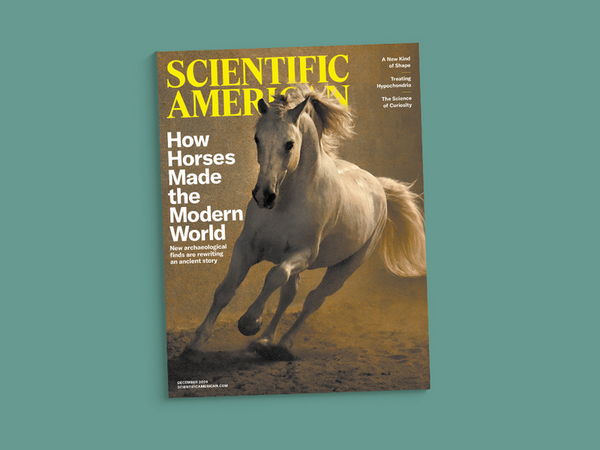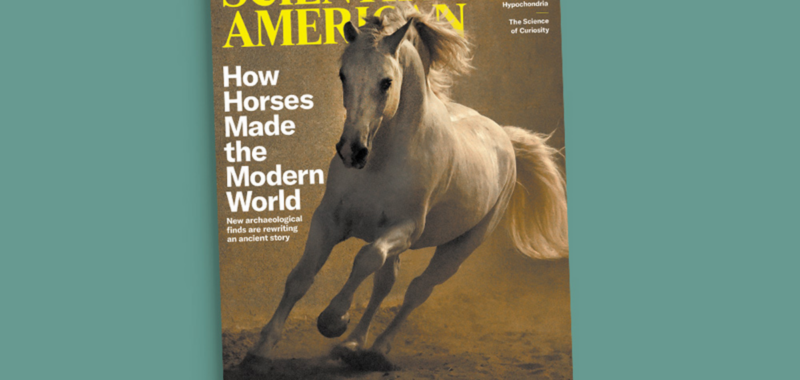November 19, 2024
3 min read
Curiosity, Horses and Hypochondria
Discovering weird new shapes, turning oil rigs into reefs and making the ocean absorb more greenhouse gases

Scientific American, December 2024
Did you grow up around horses? If not, your parents or grandparents or greats probably did. Until very recently, horses were our main means of transportation and labor. Humans have been hunting horses since around 300,000 years ago, but when did our relationship with them change from predator-prey to partner? New archaeological and genetic discoveries have changed the understanding of horse domestication. Rather than a gradual process that began around 6,000 years ago, domestication seems to have happened quickly, around 4,000 years ago, and it abruptly changed trade routes, technology and conquest. Archaeozoologist William T. Taylor shares his own research and pulls together evidence from burial sites, bits, genes and human history to show how horses made the modern world.
Don’t you love it when mathematicians figure out a problem and then realize nature beat them to it? In a fun and beautifully illustrated story, science writer Elise Cutts shows how three-dimensional shapes with minimal corners can fit together to fill a space. It’s another new insight from the field of tessellation, which has been on a tear recently. (You may remember our story in the January 2024 issue about newfound Einstein tiles, shapes that can fit together infinitely without repeating a pattern.) The iridescent wash on our illustrations may remind you of nautilus shells, which contain the newly defined shapes.
The ocean has absorbed about 25 percent of the carbon dioxide released by fossil-fuel burning since the industrial revolution began. This has slowed the pace of global warming—giving us enough time to fix it, we hope. Scientists have speculated for decades that it could be possible to increase the rate of absorption, and now marine carbon dioxide removal efforts are beginning at scale. Oceanographer Jaime B. Palter describes strategies being tested or implemented now to absorb more of the CO2 in the ocean so it can pull more CO2 from our atmosphere, with helpful, elegant graphics.
On supporting science journalism
If you’re enjoying this article, consider supporting our award-winning journalism by subscribing. By purchasing a subscription you are helping to ensure the future of impactful stories about the discoveries and ideas shaping our world today.
Hypochondria is a serious health condition that is starting to get more respectful, insightful and effective treatments. The term can refer to excessive fears about getting an illness or anxiety that some symptom is a sign of a catastrophic health condition. People affected by a new type of hypochondria called cyberchondria spend inordinate amounts of time studying medical conditions online or visiting multiple doctors. Like other anxiety disorders, hypochondria can be disruptive and tormenting. It can frustrate physicians who can’t find a “real” condition to diagnose and treat. Health reporter Joanne Silberner covers the latest findings on how to diagnose and treat hypochondria, including advice for people who want to help someone with the condition.
Offshore oil rigs have become havens for fish, shrimp, mussels, anemones, and more, serving as artificial reefs in otherwise open water. In the Gulf of Mexico, they’ve allowed red snapper and other species to expand their ranges and populations. When it’s time to decommission an oil rig, the platform and upper part of its support structure can be removed, leaving the bottom part to the fishes. California now faces a difficult decision over whether to “rig-to-reef” some of its aging offshore rigs. Freelance writer Asher Radziner explains the stakes, the science and the controversy.
Curiosity has been challenging to study because it’s hard to define exactly what it is. It’s a desire to gain knowledge and reduce uncertainty, sure, but it’s also something delicious and stimulating and fun. I suspect all of you would score high on any curiosity scale—learning about the world through science is one of the best ways to satisfy curiosity … and encourage even more of it. Scientific American Science of Health columnist Lydia Denworth explores how curiosity influences memory and learning, what brain states underlie it, and how to help young people develop it.

